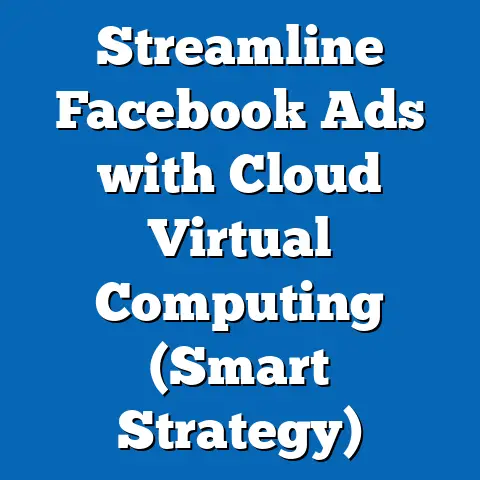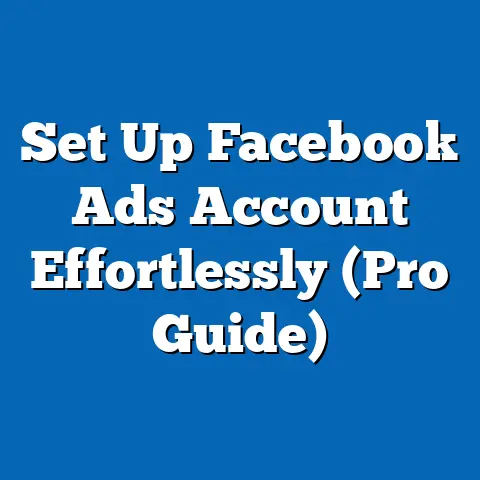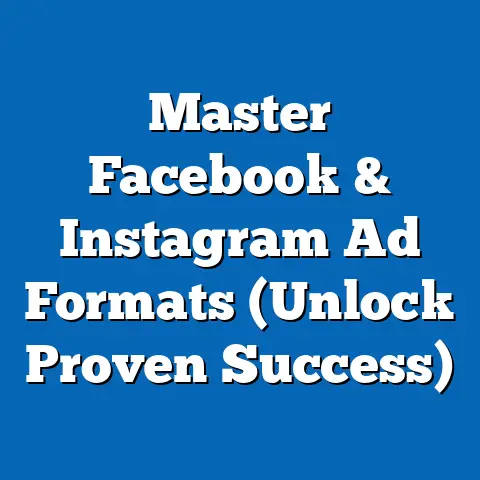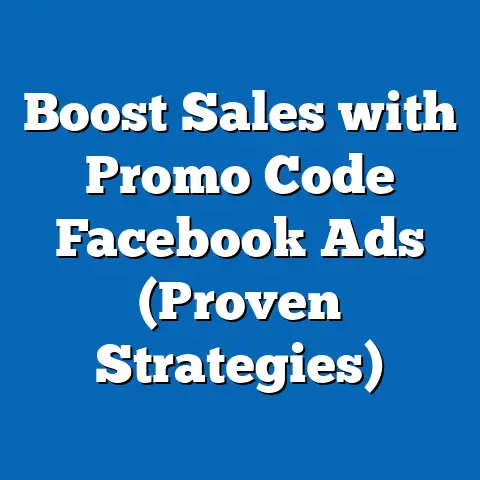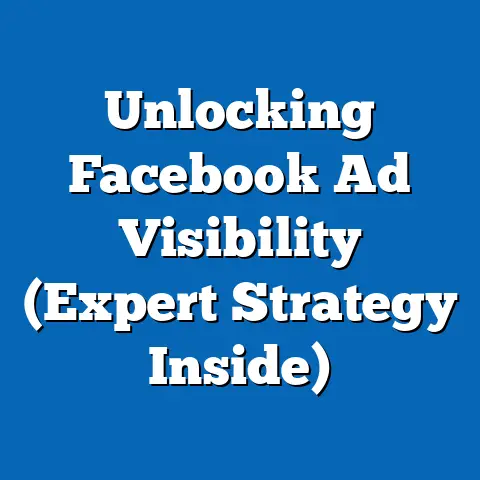Mastering Facebook Ads Auctions (Proven Strategies Revealed)
The digital marketing landscape is a constantly shifting battlefield, and to conquer it, you need to be armed with the best strategies. In this arena, mastering Facebook Ads auctions isn’t just an advantage – it’s an absolute necessity for any brand striving to outpace its competition and maximize ROI. I’ve seen firsthand how a deep understanding of these auctions can transform a struggling campaign into a roaring success. It’s not just about throwing money at Facebook; it’s about understanding the rules of the game and playing them to your advantage.
The Facebook Ads platform is a powerful tool, but like any tool, its effectiveness hinges on the user’s skill. Over the years, I’ve worked with countless businesses, from small startups to large corporations, and the one thing that consistently separates the winners from the losers is their grasp of the auction dynamics. This article is my attempt to distill that knowledge into a set of proven strategies that you can implement immediately. Get ready to unlock the secrets to winning Facebook Ads auctions and driving unparalleled results for your business.
Understanding Facebook Ads Auctions
At its core, the Facebook Ads auction is a system designed to determine which ads are shown to which users at any given moment. Think of it as a real-time bidding process where advertisers compete for the attention of Facebook’s vast audience. But it’s not just about who has the deepest pockets. Facebook aims to deliver the best possible experience to its users, so relevance and quality play a crucial role.
The mechanics of the auction are complex, but the underlying principles are straightforward. When a user visits Facebook, the platform instantly evaluates all eligible ads based on three primary factors:
- Bid Amount: How much are you willing to pay for a specific outcome (e.g., a click, an impression, a conversion)?
- Ad Quality: How engaging and relevant is your ad to the target audience? This is assessed through metrics like click-through rate (CTR), engagement rate, and feedback from users.
- Estimated Action Rates: How likely is your ad to achieve the desired outcome (e.g., a purchase, a lead, a website visit)? Facebook uses historical data and machine learning to predict this.
Facebook then combines these three factors into a single “total value” score. The ad with the highest total value wins the auction and gets shown to the user. This means that even if you’re not the highest bidder, you can still win the auction if your ad is of higher quality and more likely to achieve the desired result.
This is why simply throwing money at Facebook ads rarely works. The key is to create ads that resonate with your target audience, optimize your bidding strategy, and continuously monitor and refine your campaigns. I remember one client who was consistently losing auctions despite having a sizable budget. After analyzing their ads, I discovered that their targeting was too broad and their ad copy was bland and uninspiring. By narrowing their target audience and crafting more compelling ad copy, we were able to significantly improve their ad quality score and start winning auctions consistently.
Takeaway: Understanding the Facebook Ads auction is the first step to mastering it. Remember that it’s not just about the bid amount; ad quality and estimated action rates are equally important.
The Bid Strategy Spectrum
Facebook offers a variety of bidding strategies designed to cater to different campaign goals and objectives. Choosing the right bidding strategy is crucial for maximizing your ROI and achieving your desired results. Let’s break down the most common options:
-
Cost Per Click (CPC): With CPC bidding, you pay each time someone clicks on your ad. This is a good option if your primary goal is to drive traffic to your website or landing page. It allows you to control your spending based on actual clicks, making it a cost-effective option for generating awareness and driving initial interest. I’ve found that CPC bidding works particularly well for campaigns targeting a broad audience with the goal of driving initial awareness and interest.
-
Cost Per Thousand Impressions (CPM): CPM bidding charges you for every 1,000 times your ad is shown, regardless of whether people click on it. This strategy is best suited for campaigns focused on building brand awareness and reaching a large audience. If your goal is to get your brand in front of as many people as possible, CPM bidding can be an efficient way to do so. One of my clients, a new clothing brand, used CPM bidding to generate buzz around their launch. By targeting a broad demographic of fashion-conscious individuals, they were able to create a significant amount of brand awareness in a short period.
-
Cost Per Action (CPA): CPA bidding allows you to pay only when someone takes a specific action, such as making a purchase, filling out a form, or downloading an app. This is the most performance-driven bidding strategy and is ideal for campaigns focused on generating leads, driving sales, or achieving other specific conversions. CPA bidding requires a well-optimized landing page and a clear understanding of your target audience’s behavior. I’ve seen CPA bidding deliver exceptional results for clients with a strong sales funnel and a compelling offer.
Cost Per Click (CPC): With CPC bidding, you pay each time someone clicks on your ad. This is a good option if your primary goal is to drive traffic to your website or landing page. It allows you to control your spending based on actual clicks, making it a cost-effective option for generating awareness and driving initial interest. I’ve found that CPC bidding works particularly well for campaigns targeting a broad audience with the goal of driving initial awareness and interest.
Cost Per Thousand Impressions (CPM): CPM bidding charges you for every 1,000 times your ad is shown, regardless of whether people click on it. This strategy is best suited for campaigns focused on building brand awareness and reaching a large audience. If your goal is to get your brand in front of as many people as possible, CPM bidding can be an efficient way to do so. One of my clients, a new clothing brand, used CPM bidding to generate buzz around their launch. By targeting a broad demographic of fashion-conscious individuals, they were able to create a significant amount of brand awareness in a short period.
Cost Per Action (CPA): CPA bidding allows you to pay only when someone takes a specific action, such as making a purchase, filling out a form, or downloading an app. This is the most performance-driven bidding strategy and is ideal for campaigns focused on generating leads, driving sales, or achieving other specific conversions. CPA bidding requires a well-optimized landing page and a clear understanding of your target audience’s behavior. I’ve seen CPA bidding deliver exceptional results for clients with a strong sales funnel and a compelling offer.
Choosing the right bidding strategy depends on your specific goals and objectives. If you’re just starting out, I recommend experimenting with different strategies to see what works best for your business. Facebook also offers automated bidding options, such as “Lowest Cost” and “Target Cost,” which can be helpful for those who are new to the platform or who want to optimize their campaigns without manually adjusting bids.
Takeaway: Understanding the different bidding strategies available on Facebook is essential for maximizing your ROI. Choose the strategy that aligns with your campaign goals and objectives, and be prepared to experiment and adjust as needed.
Optimizing Ad Quality
Ad quality is a critical factor in the Facebook Ads auction. Facebook wants to show users ads that are relevant, engaging, and valuable. Ads with high-quality scores are rewarded with lower costs and better placement, while low-quality ads are penalized.
Several factors contribute to ad quality, including:
- Relevance: How well does your ad match the interests and needs of your target audience?
- Engagement: How likely are people to interact with your ad (e.g., click, like, share, comment)?
- Landing Page Experience: How relevant and user-friendly is the landing page your ad directs people to?
- Feedback: What kind of feedback are users giving about your ad (e.g., positive comments, negative reports)?
To improve your ad quality, focus on creating ads that are highly relevant to your target audience. Use clear and concise language, compelling visuals, and a strong call to action. Make sure your landing page is optimized for conversions and provides a seamless user experience.
A/B testing is an essential tool for optimizing ad quality. Experiment with different headlines, images, and ad copy to see what resonates best with your target audience. Use Facebook’s Audience Insights tool to gain a deeper understanding of your audience’s interests, behaviors, and demographics.
I once worked with a client who was struggling to generate leads through their Facebook ads. After analyzing their ads, I discovered that their ad copy was too generic and didn’t speak directly to their target audience’s pain points. By rewriting their ad copy to address their audience’s specific needs and concerns, we were able to significantly improve their ad quality score and generate a flood of new leads.
Takeaway: Ad quality is a critical factor in the Facebook Ads auction. Focus on creating ads that are highly relevant, engaging, and valuable to your target audience. Use A/B testing and audience insights to continuously optimize your ads for maximum impact.
Leveraging Audience Targeting
Effective audience targeting is the cornerstone of any successful Facebook Ads campaign. By targeting the right people with the right message, you can significantly improve your ad relevance, engagement, and conversion rates.
Facebook offers a wide range of targeting options, including:
- Demographics: Target people based on age, gender, location, education, and other demographic factors.
- Interests: Target people based on their interests, hobbies, and passions.
- Behaviors: Target people based on their online and offline behaviors, such as purchase history, travel habits, and device usage.
- Custom Audiences: Target people who have interacted with your business in the past, such as website visitors, email subscribers, or app users.
- Lookalike Audiences: Target people who are similar to your existing customers or website visitors.
Creating lookalike audiences is a particularly powerful strategy for expanding your reach and finding new customers. By uploading a list of your existing customers to Facebook, you can create a lookalike audience of people who share similar characteristics and behaviors. This allows you to target a highly qualified audience that is more likely to be interested in your products or services.
Retargeting is another essential strategy for maximizing your ad performance. By retargeting people who have visited your website or interacted with your business in the past, you can remind them of your brand and encourage them to take action. Retargeting ads are often highly effective because they target people who are already familiar with your business and have shown an interest in your products or services.
I once worked with a client who was struggling to generate sales through their Facebook ads. After analyzing their targeting, I discovered that they were targeting a very broad audience with little regard for their specific interests or behaviors. By narrowing their target audience to people who had previously visited their website and expressed an interest in their products, we were able to significantly improve their conversion rates and drive a significant increase in sales.
Takeaway: Effective audience targeting is essential for maximizing your ad performance. Use Facebook’s wide range of targeting options to reach the right people with the right message. Experiment with lookalike audiences and retargeting strategies to expand your reach and drive conversions.
Utilizing Facebook’s Ad Tools and Resources
Facebook provides a suite of powerful tools and resources to help advertisers optimize their campaigns and master the auction dynamics. Leveraging these tools can give you a significant advantage over your competition.
Here are some essential tools to familiarize yourself with:
-
Facebook Ads Manager: This is your central hub for creating, managing, and analyzing your Facebook Ads campaigns. Use it to set your budget, choose your targeting options, design your ads, and track your performance.
-
Audience Insights: This tool provides valuable data about your target audience, including their demographics, interests, behaviors, and purchase habits. Use it to gain a deeper understanding of your audience and create more relevant and engaging ads.
-
Creative Hub: This tool allows you to experiment with different ad formats and design elements to see what resonates best with your target audience. Use it to create mockups of your ads and share them with your team for feedback.
-
Facebook Pixel: This is a snippet of code that you install on your website to track the actions that people take after clicking on your Facebook ads. Use it to measure your conversion rates, optimize your campaigns for specific goals, and retarget people who have visited your website.
Facebook Ads Manager: This is your central hub for creating, managing, and analyzing your Facebook Ads campaigns. Use it to set your budget, choose your targeting options, design your ads, and track your performance.
Audience Insights: This tool provides valuable data about your target audience, including their demographics, interests, behaviors, and purchase habits. Use it to gain a deeper understanding of your audience and create more relevant and engaging ads.
Creative Hub: This tool allows you to experiment with different ad formats and design elements to see what resonates best with your target audience. Use it to create mockups of your ads and share them with your team for feedback.
Facebook Pixel: This is a snippet of code that you install on your website to track the actions that people take after clicking on your Facebook ads. Use it to measure your conversion rates, optimize your campaigns for specific goals, and retarget people who have visited your website.
Analytics are your best friend when it comes to refining your strategies. Don’t just set up your ads and forget about them. Regularly review your campaign performance data to identify areas for improvement. Pay close attention to metrics like click-through rate (CTR), conversion rate, cost per click (CPC), and return on ad spend (ROAS).
By leveraging these tools and resources, you can gain a deeper understanding of your target audience, create more effective ads, and optimize your campaigns for maximum ROI. I’ve consistently seen that advertisers who actively utilize these tools achieve significantly better results than those who don’t.
Takeaway: Facebook provides a suite of powerful tools and resources to help advertisers optimize their campaigns. Familiarize yourself with these tools and use them to gain a deeper understanding of your target audience, create more effective ads, and track your performance.
Monitoring and Adjusting Campaigns
The Facebook Ads auction is a dynamic environment, and your campaigns need to be constantly monitored and adjusted to stay ahead of the curve. Don’t make the mistake of setting up your ads and forgetting about them. Regularly review your campaign performance data to identify areas for improvement.
Here’s a step-by-step approach to monitoring and adjusting your campaigns:
- Set up tracking: Make sure you have the Facebook Pixel installed on your website and that you are tracking the key actions that you want to measure (e.g., purchases, leads, website visits).
- Monitor your metrics: Regularly review your campaign performance data in Facebook Ads Manager. Pay close attention to metrics like click-through rate (CTR), conversion rate, cost per click (CPC), and return on ad spend (ROAS).
- Identify areas for improvement: Look for trends and patterns in your data. Are certain ads performing better than others? Are certain targeting options more effective?
- Make adjustments: Based on your analysis, make adjustments to your bids, budgets, targeting, and ad creative.
- Test your changes: Before making significant changes to your campaigns, test your changes on a small scale to see how they perform.
- Repeat: Continuously monitor your campaign performance and make adjustments as needed.
I’ve found that even small adjustments can have a significant impact on campaign performance. For example, simply changing the headline on an ad can often lead to a significant increase in click-through rate.
Remember that the Facebook Ads auction is a competitive environment. Your competitors are constantly trying to optimize their campaigns, so you need to be vigilant and proactive to stay ahead of the curve.
Takeaway: Monitoring and adjusting your campaigns is essential for maximizing your ROI. Regularly review your campaign performance data, identify areas for improvement, and make adjustments as needed.
Conclusion
Mastering the Facebook Ads auction is not a one-time task but an ongoing process of learning, experimentation, and optimization. By understanding the dynamics of the auction, choosing the right bidding strategies, optimizing your ad quality, leveraging audience targeting, utilizing Facebook’s ad tools, and continuously monitoring and adjusting your campaigns, you can significantly improve your ad performance and achieve measurable results.
The strategies I’ve shared in this article are based on my years of experience working with businesses of all sizes. I’ve seen firsthand how these strategies can transform a struggling campaign into a roaring success.
I encourage you to implement these strategies in your own Facebook Ads campaigns and see the difference they can make. Don’t be afraid to experiment and try new things. The key is to stay curious, stay informed, and never stop learning.
Now, I’d love to hear from you. What are your experiences with Facebook Ads auctions? What strategies have worked best for you? Share your thoughts and insights in the comments below. And if you found this article helpful, please share it with your fellow marketers who are looking to improve their ad strategies. Together, we can all master the Facebook Ads auction and achieve unparalleled success in the world of digital marketing.

